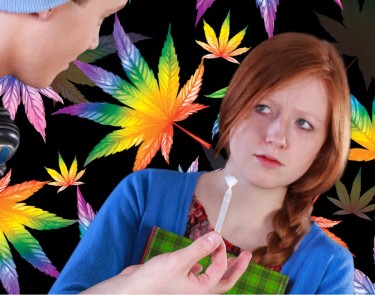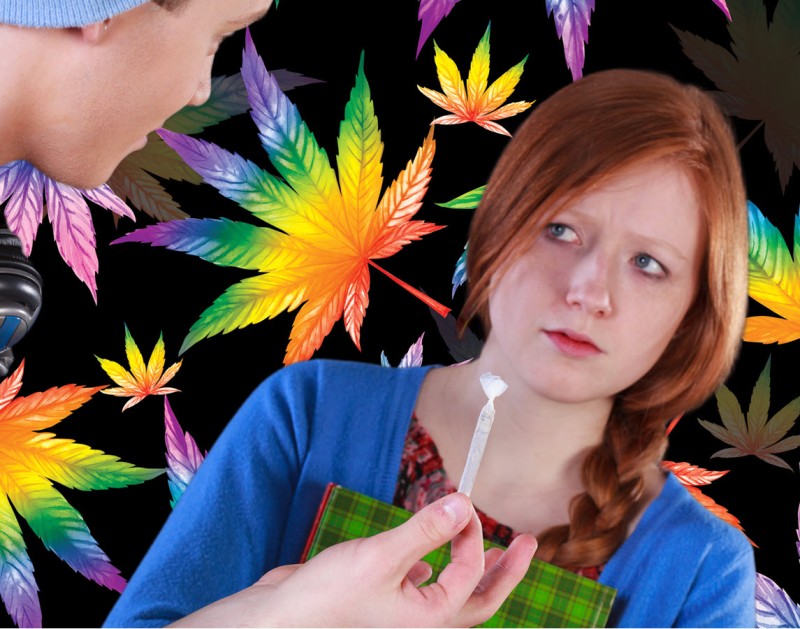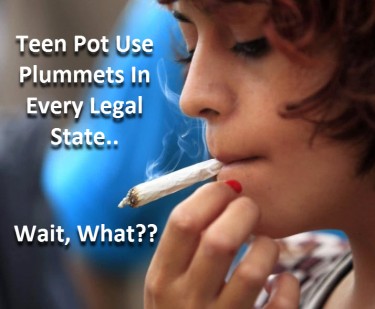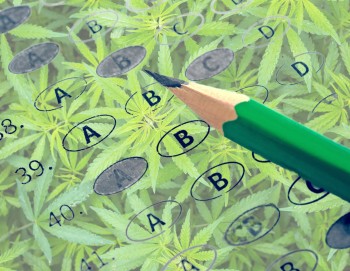
Turns out the kids were alright
As Cannabis.net covered the latest teen marijuana study here, turns out teen marijuana use does not go up with legalization.
For decades, prohibitionists have claimed that legalizing cannabis would send the wrong message to kids, leading to rampant increases in underage marijuana use. "We'd basically be telling our youth that it's acceptable," they argued, using the talking point to stir moral panic and block reform efforts. However, now that data is emerging from the growing number of states ending prohibition, those old arguments are crumbling.
New federal survey results continue to defy the notion that legalization enables youth access and promotes teen consumption. In fact, the trends seem to reveal quite the opposite - despite nearly a dozen more states opening recreational markets since 2020, underage marijuana use has remained completely stable according to the latest Monitoring the Future (MTF) study. So much for the theory that legal dispensaries on every corner would lead to our children blazing up with abandon.
It turns out all that rhetoric about sending the "wrong message" was just reefer madness without evidence. Teen marijuana use has not risen "even as state legalization has proliferated across the country," according to federal health officials. If anything, perceptions of risk and lack of availability seem to have discouraged underage experimentation beyond pre-pandemic rates.
The data makes it clear - our long-held fears about how ending prohibition would influence kids were based on guesswork and stigma, not facts. Our drug policies led to the incarceration and marginalization of millions - and for what? The same groups we claimed to "protect" show no differences in use rates based on legality. It's the latest evidence that this moral panic was overblown from the start.
So in today's article, we'll analyze the recent federal survey results and trends over time to explore why legalization seems to have so little influence on real teen behavior. We'll discuss what it means for the outdated idea that prohibition somehow shields youth. And we'll reflect on how biased drug war messaging ultimately caused far more harm to society than cannabis itself ever could. The facts require us to rethink everything we were taught about "sending messages" to the young. It's time to have an honest discussion based in truth.
Let’s take a look at the data
Taking a closer look at the latest federal data reveals stable trends in teen marijuana use that fail to support prohibitionist rhetoric. The Monitoring the Future (MTF) survey showed no statistically significant increases in adolescent cannabis consumption from 2020 to 2022, even as more states enacted legalization policies.
According to the survey results, past-month marijuana use for 8th, 10th and 12th graders has hovered between 6.6 - 8.3%, 16.5 - 17.8%, and 28.4 - 29% respectively over the past three years. These rates remain below pre-pandemic levels as well, despite historic highs in adult use. In other words, the data suggest that "whatever is happening with adult-use legalization across the country has not really impacted the younger people," says Chief Marsha Lopez of the National Institute on Drug Abuse (NIDA)'s epidemiology branch.
Even perceptions of cannabis access and availability are on the decline among adolescents, bucking expectations. "In fact, that has been trending downward over the years," Lopez remarked. This reveals the flaw in arguments that more dispensaries automatically enable diversion to kids - if anything, regulated markets appear to reduce youth access. Lopez also highlighted the "steadier declines in the perception of harm without the corresponding increases in use" typically expected as stigma drops.
In essence, neither perceived harm nor availability seem correlated to actual teen consumption patterns amid continuing legalization efforts.
Additionally, the prevalence of daily adolescent marijuana use has held "remarkably steady for the last 10 years," showing little fluctuation even as recreational markets started opening. This challenges rhetoric about the "normalization" of cannabis somehow promoting increased habitual use. In fact, Lopez shared that "there have been no substantial increases at all" in that daily use rate.
Comparisons between prohibition states and those with medical marijuana laws also showed no statistically significant differences in past-year consumption rates among teenagers of any grade. The slight variances that did appear followed no predictable pattern regarding policy outlook. For instance, 8th graders in medical states saw cannabis as less risky but weren't more likely to use it. The evidence does not support clear associations between any given regulatory scheme and youth behavior changes.
Ultimately the survey data reveals stable equilibriums in adolescent marijuana use over time, regardless of broader legalization efforts. This fails to explain why teen behavior would somehow hinge more on criminalization policies that primarily affect adults. In essence, the data shows kids will be kids whether we end prohibition or not. The expectations that legalization would clearly influence youth were biased speculation without solid basis.
Why the Data isn’t surprising
When prohibition ends, the expectation might be that sudden availability will lead to rampant youth access and use. Yet historically, illicit drugs have remained widely available to teens regardless of illegality. Meanwhile, no policy can fully prevent adolescent experimentation. So in many ways, stable youth usage despite legalization makes intrinsic sense.
Even under prohibition, underground markets thrive off demand from all ages. Minors who want to use cannabis have always been able to get it through peer connections, whether legal dispensaries exist or not. Perhaps the only real difference is removing criminal middlemen who once enabled thataccess.
With storefronts checking IDs and limiting diversion, many youth actually perceived decreasing availability post-legalization. So the assumption that simply having aboveboard retail options would automatically expand teen access appears flawed. If anything, regulation chokes off the supply chanels they relied upon.
And when policy changes fail to significantly impact access, use levels follow suit. Adolescents consume based more on developmental factors, peer pressure and perceived harms over mere availability. Since legalization didn't drastically alter these core drivers, stability isn't shocking.
Essentially, teens will be teens, whether cannabis sits behind the counter legally or gets slipped covertly. Usage rates reflect larger cultural influences beyond regulated sales. The same kids occasionaly smoking weed illegally are largely still doing so post-reform because external deterrents remain similar. Criminalization simply pushes activities underground without preventing them.
In that sense, bringing cannabis commerce into daylight may even provide opportunities to deter youth use through candid education over scare tactics. Where prohibition breeds mystery and allure, realistic guidance on moderation could help lead by example.
We see it with alcohol - despite legality and availability, less than 15% of U.S. teens drink weekly because acceptance coexists with transparency about risks. Perhaps the same balance can be struck over time regarding youth and cannabis as reform advances.
In states with established legal markets, generations are gradually growing up knowing cannabis exists openly in society, like alcohol. But thus far data doesn't show that environment significantly increasing their likelihood to use it. Kids aren't suddenly picking up new habits simply because local dispensaries start opening under a taxed and regulated model.
And even where experimentation occurs, the risks remain similar to legal substances. As with alcohol, only a small fraction go on to seriously problematic usage. Most reflect the moderate majority who exercise free choice responsibly regardless of policy. So whether modern youth live under prohibition or legalization, behaviors stay largely the same.
Perhaps these insights give hope that ending criminalization need not equate to condoning increased use - including for teens. Like alcohol, safe enjoyment in moderation needn't be forfeited to prevent hazardous excess. And reasonable laws needn't forfeit rights to curb abuses most wouldn't consider exercising anyway.
With the myth of legalization enabling youth use scientifically shattered, we must rethink what example society should set. Does continuing a failing prohibition actually protect kids - or progress towards system that equips people of all ages to make wiser choices? The choice is ours to make policies based on facts over fears.
The Sticky Bottom Line
When we peel back the layers on teen marijuana use amid legalization, the bottom line remains quite sticky - both literally and figuratively. Not only have fears of increased youth consumption failed to materialize, but the assumptions behind prohibition have always clung to rhetoric over reason. They persist more from their addictive power to control than any scientific validity.
The data makes it clear - our policies have long been shaped more by bias than facts regarding cannabis and youth. We allowed the spread of misinformation to perpetuate a system that treated morality as reality. We sacrificed ethical considerations for generations based on little more than hazy speculation, vested interests and saccharine myths.
In the process, how many lives and families suffered collateral damage from excessive penalties over a relatively benign substance? How many youths endured lasting impacts from a criminal record over minor possession? The projections about sending "messages" to kids proved far less credible than the harms enacted upon them in the name of protection.
And behind it all lies the bigger ethical dilemma - by what right does any authority dictate what individuals can safely consume, or deny access without just cause? At what point is it not only impractical but immoral to limit personal freedoms preemptively based on puritanical notions of societal danger? The line between protection and oppression blurred long ago.
Perhaps it's time we reassess the balance of responsibility regarding rights related to cannabis, its risks relative to legality, and our desire to control cohorts who never asked for protection. The data shows adolescent use changes little either way. But one choice inflicts less harm on those claimed to safeguard.
As legalization marches forward, bringing transparent cannabis commerce along, we must reflect on how many of our policies still stem from reactionary worry over reason. How much of our lives remain controlled by the whims of those in power? And how the myths they peddle frequently do more damage than the vices they supposedly protect us from?
The choice of what messages we send our youth remains sticky. But clear data helps cut through the muddy logic of prohibition. Beyond fear-based talking points lies a rational discussion worth having on complex comparisons of legality versus morality.







